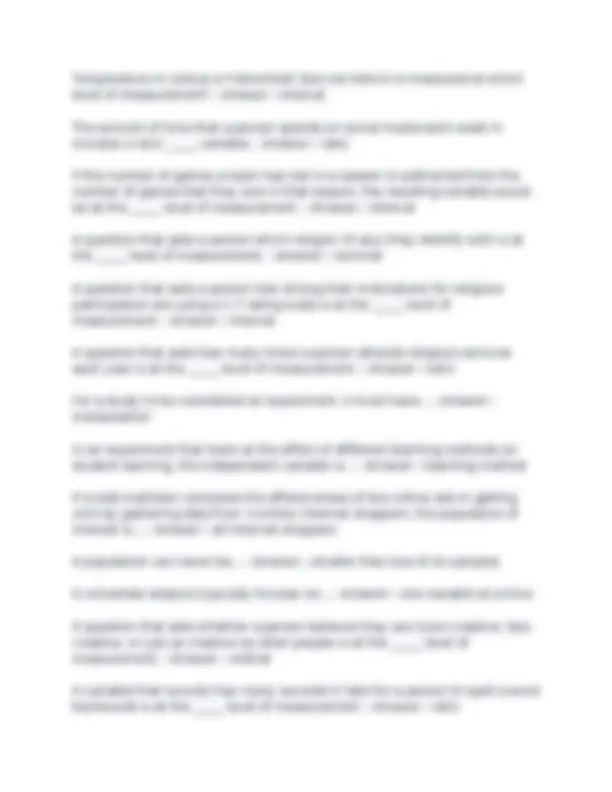



Study with the several resources on Docsity

Earn points by helping other students or get them with a premium plan


Prepare for your exams
Study with the several resources on Docsity

Earn points to download
Earn points by helping other students or get them with a premium plan
Community
Ask the community for help and clear up your study doubts
Discover the best universities in your country according to Docsity users
Free resources
Download our free guides on studying techniques, anxiety management strategies, and thesis advice from Docsity tutors
An overview of key statistical concepts and principles covered in an introductory statistics course. It covers topics such as sampling, levels of measurement, variables, and experimental design. Sample questions and correctly solved answers, making it a valuable resource for students studying statistics at the university level. The content is structured in a clear and concise manner, making it suitable for use as study notes, lecture notes, or a summary of the core statistical concepts. The document could be particularly useful for students enrolled in introductory statistics courses in fields such as social sciences, business, or the natural sciences, as it covers the foundational knowledge required to understand and apply statistical methods in research and data analysis.
Typology: Exams
1 / 2

This page cannot be seen from the preview
Don't miss anything!


A sample is a part of a larger... --Answer-- population A bivariate analysis typically focuses on... --Answer-- the association of two variables. Inferential statistics are typically contrasted with _____ statistics. --Answer-- descriptive Which of the following is a defining characteristic of experiments? --Answer-- Manipulations The respondent's gender is typically recorded as a(n) _____ variable. -- Answer-- nominal In an experiment, the variable that the researcher manipulates is called the _____ variable. --Answer-- independent Which is bigger: a sample or a population? --Answer-- a population A variable that classifies people into racial or ethnic groups is what level of measurement? --Answer-- nominal Which level of measurement has a true zero point? --Answer-- ratio The number of students enrolled in a school each year is an example of which level of measurement? --Answer-- ratio If a researcher is able to survey 99% of all students enrolled in statistics classes at a college, then that researcher has gathered data from a(n)... -- Answer-- sample The variable that is measured as the outcome in an experiment is called the _____ variable. --Answer-- dependent
Temperature in celsius or Fahrenheit (but not Kelvin) is measured at which level of measurement? --Answer-- interval The amount of time that a person spends on social media each week in minutes is a(n) _____ variable. --Answer-- ratio If the number of games a team has lost in a season is subtracted from the number of games that they won in that season, the resulting variable would be at the _____ level of measurement. --Answer-- interval A question that asks a person which religion (if any) they identify with is at the _____ level of measurement. --Answer-- nominal A question that asks a person how strong their motivations for religious participation are using a 1-7 rating scale is at the _____ level of measurement. --Answer-- interval A question that asks how many times a person attends religious services each year is at the _____ level of measurement. --Answer-- ratio For a study to be considered an experiment, it must have... --Answer-- manipulation In an experiment that looks at the effect of different teaching methods on student learning, the independent variable is... --Answer-- teaching method If a web marketer compares the effectiveness of two online ads in getting click by gathering data from 3 million Internet shoppers, the population of interest is... --Answer-- all internet shoppers A population can never be... --Answer-- smaller than one of its samples A univariate analysis typically focuses on... --Answer-- one variable at a time A question that asks whether a person believes they are more creative, less creative, or just as creative as other people is at the _____ level of measurement. --Answer-- ordinal A variable that records how many seconds it take for a person to spell a word backwards is at the _____ level of measurement. --Answer-- ratio